Jun
19
2012


I was graciously given the Yashica Samurai by a friend who recognized that it would interest me, and it does. It’s a half frame camera producing 50 negatives from a standard 24 exposure roll of film. That itself is interesting, it makes you feel less encumbered by the preciousness of the film. It feels almost like shooting digitally you have so many exposures available. Then there is the form of the camera, which is somewhere between an old video camera and a…..I got nothing it’s between an old video camera and nothing. It is an actually SLR with a mirror and a direct view through the lens but rather than the film travelling horizontally the film travels vertically like it would in a movie camera. This provides the opportunity to create vertical stitches of images on the film which I will cover in a later post. The lens is a 25 to 75mm zoom which because of the half frame nature of the camera translates into a 35mm equivalent of 35 to 105mm. Despite being an SLR the camera doesn’t allow manual control or overide of the exposure so it’ functions more like any other point and shoot film camera that looks like a video camera from 1993.
2 comments | tags: film, Yashica | posted in Cameras, Photography, Uncategorized
Jun
9
2012
I’ve been playing around with editing some digital files on the iPad even before I have uploaded them to my computer. One of the things this allows is the freedom to go over the top with the processing, just as most of the images on social sharing services have digital filters applied, editing on the iPad seems like a license to do it there as well. Would I want all my images to be square and highly saturated? No, but there is a certain appeal to it.
no comments | tags: Digital, iPad, Photography | posted in Photography, Processing, Uncategorized
Jun
3
2012
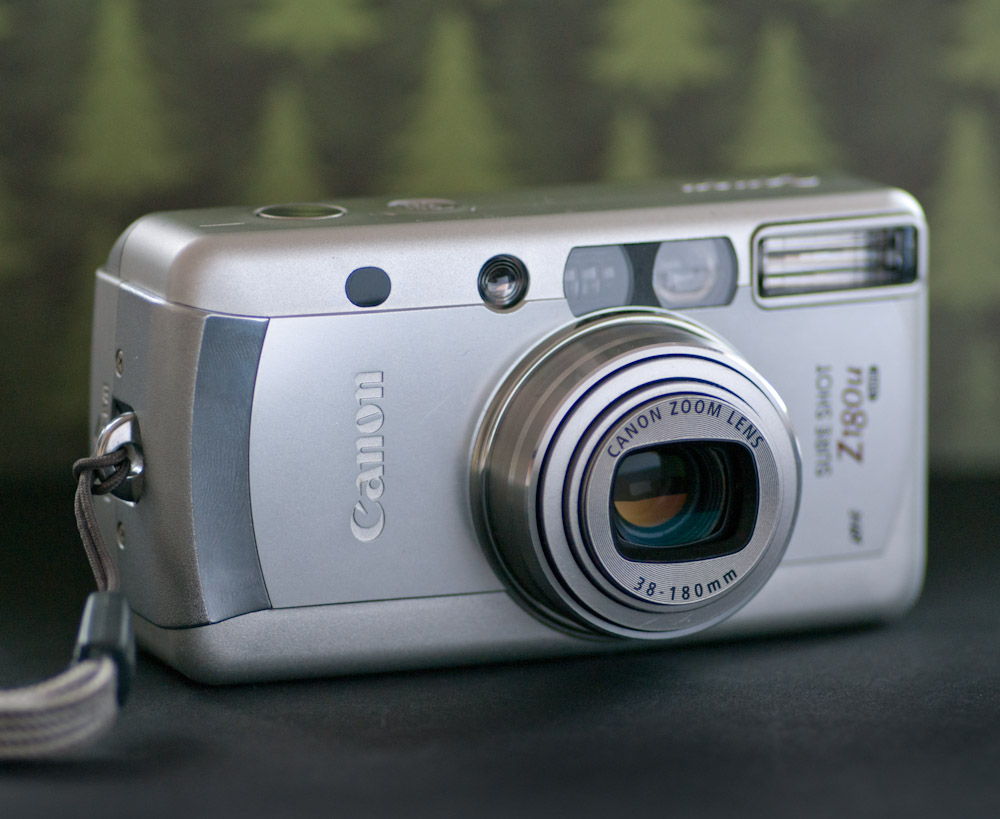
The Canon z180u is an interesting camera for the particular reason that it came out at the end of 2004 a time when it was already apparent that digital cameras were not just the future but the now. This is the same year that I bought my Sony DSC-V3 advanced digital compact, in this case ironically over the Canon G6. So as the top model of the range and nearly the last new film camera it contains many technologically advanced features. Some of these include three point auto focus, an CMOS exposure sensor, two aspherical lens elements and a focus assist lamp. What I like though is something that doesn’t even show up in the specifications, it is extremely quiet. The shutter is quiet the focus is quiet and even the film advance is quiet. In addition when you turn the camera off and on it remembers the last settings, this is important to me as I like to have the flash disabled most of the time.

The lens is a serious compromise though. To be as compact as it is and still provide a 38-180 zoom it is slow as in f5.6 at 38mm and f12.9 at 180mm that’s too bad because it’s an other wise great point and shoot. But just as there has been a mega-pixel race there was a zoom race too and this is the trade off.

no comments | tags: camera, film, P&S | posted in Cameras, Photography, Uncategorized
Apr
13
2012
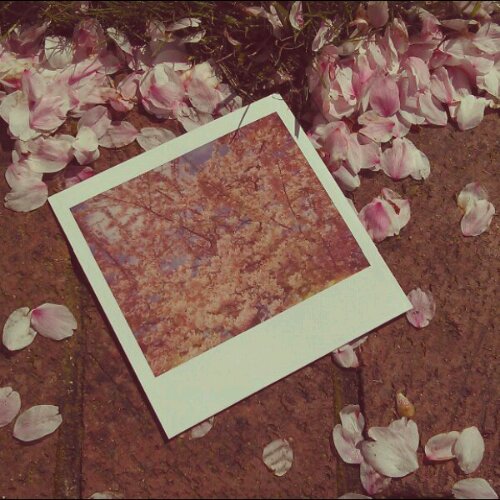
I like the idea of being able to post to my blog from where ever I am. I already upload images to Mytubo, Instagram and the “Facebook” so why not my blog. It works to a degree, from Instagram rather than posting the image it posts a link back to Instagram, not all that surprising really. From my Android phone itself I can blog with the WordPress app including editing existing posts as I did here adding the image to the post from Instagram. http://instagr.am/p/JYBngIPUnN/
Layout is a problem though as the images no matter how I handle them seem to overlap the menus on the right, still more work there.
no comments
Mar
2
2012
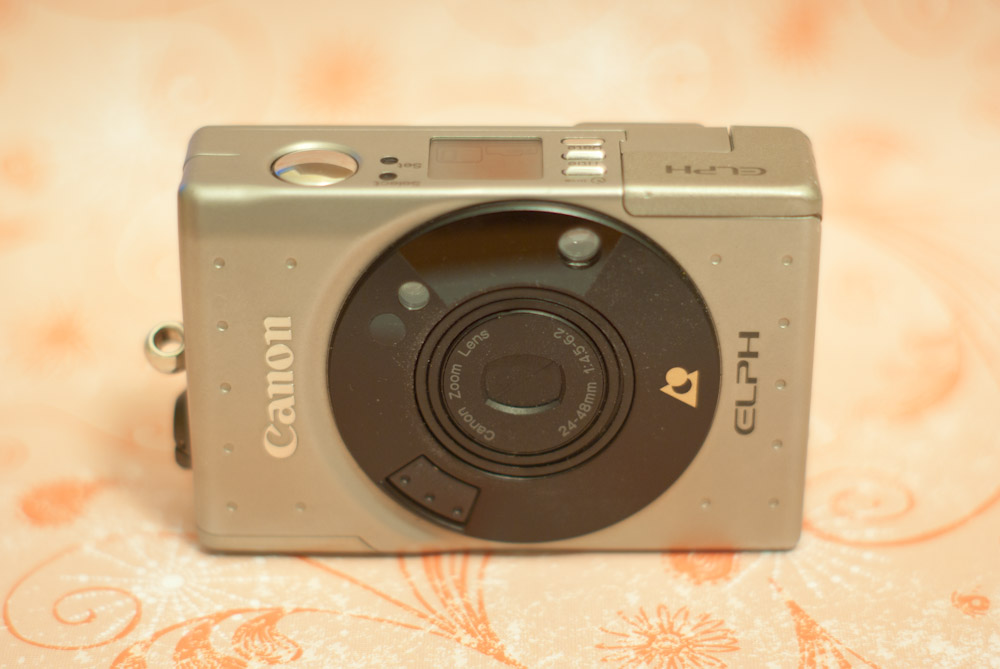
The canon Elph is a very diminutive yet substantial APS film camera that came out in 1996. So many camera’s since have used the Elph moniker but this was Canon’s first as well as their first APS camera. It only has a 2 times zoom and a very pedestrian F4.5 maximum aperture but these are the sort of compromises that were made to create such a small camera. It weighs 180 grams but feels like so much more, I think because of how dense it is. The shell is made from a stainless steel alloy according to Canon and based on the small nicks and dings in my second hand copy it can take quite a beating. It has few features for creative control such as a +1.5 EV backlight exposure compensation that is determined by the camera and not user selectable. It does allow slow speed flash sync and with a half press of the shutter you can focus and recompose.
This camera in my opinion is an important milestone in the miniaturization of cameras as well as design, so many digital point and shoot cameras since have had similar styling that it’s hard not to see this as the precedent of the form. As for the images produced they are actually not bad as long as they are viewed at a reasonably small size such as 5×7″ which was really the intent of these cameras, to be small and carry anywhere camera to document life, before digital cameras and cell phone cameras ever came to market. The Elph IX240 even came with a case that had a belt loop so you could carry it on your hip, at a time I might add when cell phones didn’t.
5 comments | posted in Cameras, Photography, Uncategorized
Feb
12
2012
This is some video I shot last weekend around Stave Lake BC with my DSLR. There’s no story it’s just a linear timeline of my day, I just shot some video in between the still shots.
Stave Lake from Wallace Ross on Vimeo.
no comments
Dec
19
2011
Back in olden times, when surfing the Internet was preceded by the squelch of a phone modem and required you to know the URL of the sight you wanted to go to, film manufacturers decided to make things more convenient. Not for the Internet, they didn’t see that coming, but for handling film. What they came up with was APS film and what it addressed was the loading and storage of the film. The film stayed inside the cartridge completely until loaded by the camera and was stored inside the cartridge again after being developed. People using APS film never actually saw the film itself. In creating the cartridge though they did one other significant thing and that was reduce the film size as compared to 35mm film which was and is the film size that most people are familiar with. The side effect of this reduced size is also a lowering of picture quality, especially evident when the images are enlarged beyond a certain size. Because most of these pictures where never printed larger than 5″x7″ this largely goes unnoticed.
Fast forward several years and we are now searching the Internet more effectively but not yet Googling. At this point digital photography’s is skyrocketing and film use is plummeting. APS film being the weaker of the film formats with a much smaller user base was the first to be left behind. A lot is happening within digital photography at this time, point and shoot cameras actually suck and produce inferior images and cost large sums of money. Digital SLR’s are only just becoming available and also cost large sums of money. Most DSLR’s then as now came out with either a sensor the same size as 35mm film often referred to as “full frame” or the smaller APS-c or “cropped sensor”. Why would manufacturers even bother with producing sensors the same size as the failed APS film you might ask. The reasons are mostly down to the cost of manufacturing the sensors and as it turns out the full frame ones are a lot more costly relative to there size. So in order to create a market for DSLR’s camera makers needed to bring the costs down to a point that enough people could afford them, how else could they sell lenses. I remember it was a big deal when the first sub $1000 DSLR was released in around 2006.
From day one it was clear that full frame sensors were better than APS-c ones as it had been between the two film sizes. Manufactures helped to make this clear also by putting full frame sensors in their big rugged professional cameras and APS-c sensors in their consumer offerings. And that is how it’s been for about ten years, but the thing is that sensors have been steadily improving with each new iteration and the gap in image quality between full frame and APS-c has narrowed. This may be as much a result of companies putting resources to where they feel they will get the best return. After all they are not out to produce the best camera with no concern for cost they are competing hard to stay ahead of each other in the market place. There are many more things going on in digital photography including other sensor sizes and camera forms but within the DSLR world it’s mostly about full frame and crop sensors.
So if full frame sensors result in better image quality in general then what if any advantage other than cost do crop sensors provide? Well because of there smaller size they record a narrower field of view from the same focal length lens. This is often referred to as the crop factor. This “crop factor” is roughly 1.5 times for most APS-c sensors. The result is that for example a 100mm lens on APS-c provides the same field of view as a 150mm lens on full frame. This relationship is true for any focal length so that a 300mm lens becomes equivalent to a 450mm lens on full frame. In this case it’s clearly an advantage for people wanting a long telephoto lens. The opposite is true for wide angle where what was a wide 18mm becomes equivalent to a 28mm lens on a full frame camera.
So why did I title this post revenge of APS? Well it’s been a long road but we are at a point where some of the most recent APS-c sensors can perform at the same level as full frame sensors. This may not be a universally held belief but it’s pretty easy to argue that the difference isn’t nearly what it once was. It’s true that “full frame” cameras provide a shallower depth of field, but may not be the be all end all of photography. I find myself again on the side of the argument that ends with the question. If the viewer of an image has no idea how it was made does it matter how it was made?
In a future post I will time travel back to 1996 and compare two otherwise similar cameras having the key difference that one took 35mm film and the other APS.

5 comments | tags: APS, Cameras, film, Full Frame | posted in Cameras, Photography, Uncategorized
Nov
4
2011
Previously I borrowed a Fuji F200EXR from Duncan Turner of DLT photographic , the point of which was for me to evaluate the technology that Fuji refers to as EXR. What this technology essentially does is capture two separate exposures at the sensor level at the same time by using half the total photo sights for each exposure. The trade off of this is a reduced resolution, to half of the total. The benefit is a greater dynamic range. In the case of the F200EXR the resolution drops from 12mpixels to 6 Mpixels when used in EXR dynamic range mode.
This isn’t a lab or a studio test of EXR for this camera but as close to a practical real world usage as I could make it. What I found was that the difference was subtle and it was really only necessary to go into EXR mode under harsh lighting, such as a shaded forest with bright sky in the back ground. In EXR %400 mode a similar exposure allowed for some retention of highlight detail where in full resolution mode some highlights were clipped. As there is no RAW shooting mode for this camera all images where jpegs. And here is the thing, I don’t think that the EXR results would be superior to a similar camera that allowed RAW shooting. With a slight under exposure bias to preserve highlights followed by some image adjustments during RAW conversion I think that all the stated benefits of EXR could be duplicated. In fact even the high resolution jpegs from the the F200EXR can be adjusted to produce similar results with the right exposure (again a slight under exposure to preserve highlights)
There are subtle differences between the two modes but is it enough to justify the drop in megapixels? I will answer that “No”. Both modes produce good results with the trade offs mentioned. So what do I think this means in relation to the new Fuji X10 that is being released and soon to be available? I think that the camera will need to stand on it’s other merits such as it’s fast F2.0 lens and it’s optical viewfinder because if you need to look this hard to see a real difference, your time could be better spent taking pictures. I hope I’m prove wrong when the X10 arrives as an advancement in camera technology is worth a bruise to my ego.
High Resolution mode, notice the clipped highlights on the histogram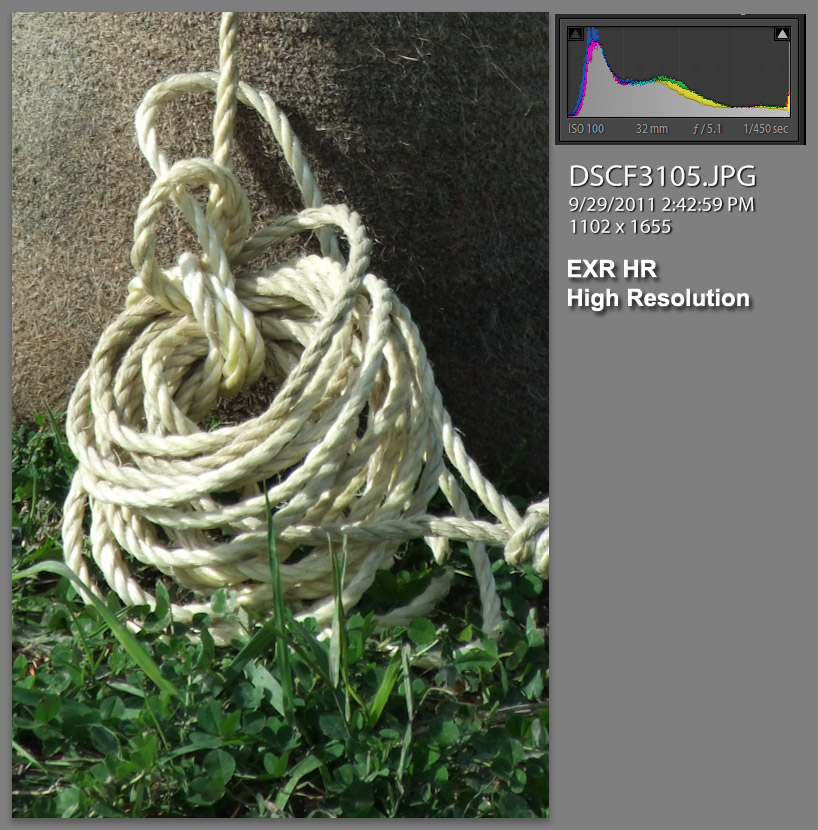
EXR High Dynamic Range
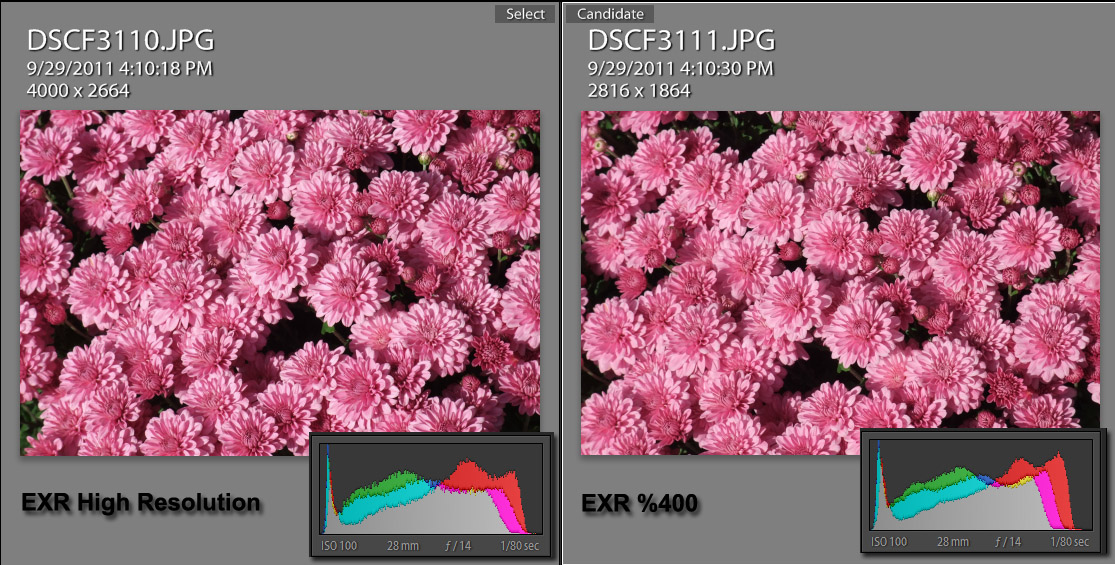
Zoomed in High Resolution on the left EXR on the right

1 comment | tags: Digital, EXR, Fuji, Photography | posted in Cameras, Photography, Uncategorized
Oct
20
2011

I love fall! It’s such a beautiful season.
Here is the polaroid from the picture.

2 comments | tags: colours, fall, polaroid
Sep
27
2011
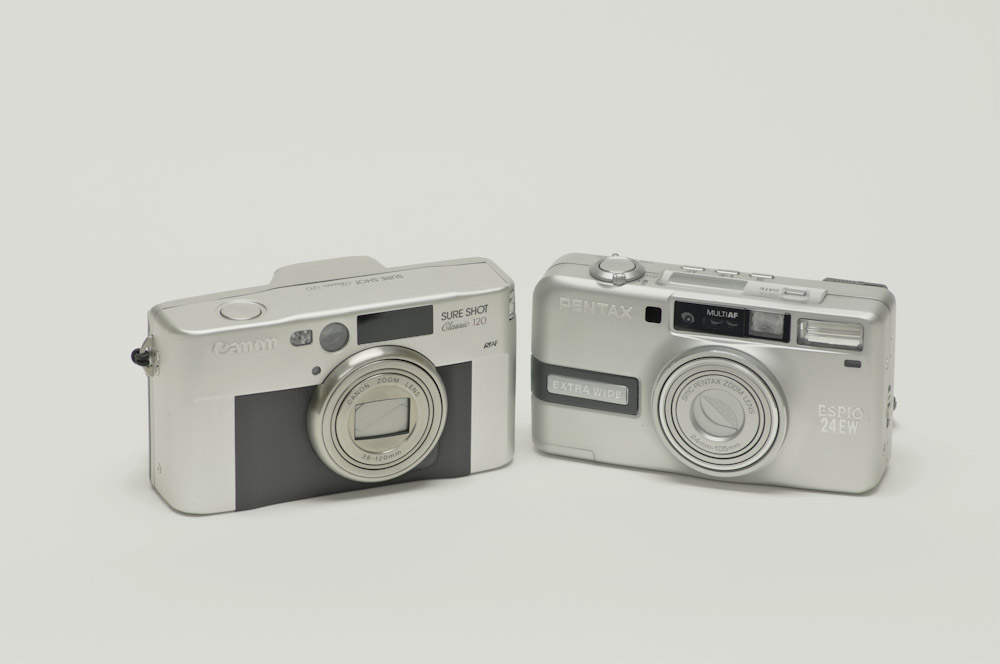
What we have here are two very good compact film cameras from that awkward time when the digital megapixel race was to get to 1.2 Million. Digital wasn’t quite there or in the mainstream and people were still wanting to take pictures of their cats. So If you wanted a good quality camera around the turn of last century (I always wanted to say that) these were two top choices.
They are well built cameras with very good optics. The Pentax 24EW has a 24mm to 105mm zoom which is very wide considering most others point and shoots of the time started around 35mm. The Canon on the other hand has a 38mm to 120mm zoom which gives a bit more reach while giving up the wide end.
One interesting feature that both cameras posses is the ability to automatically zoom to frame a portrait. If you select this mode on either camera and then give the shutter a half press they will change the zoom setting to take a head and shoulder shot of your subject. That may not be amazing for a digital camera but don’t forget these are film point and shoots, from the turn of the last century.
The Canon is considerably heavier than the Pentax which may be a detriment in some cases but allows it to remain standing even when fully zoomed.

You can also see in this picture that the Canon flash has popped out of it’s side bay door. It does that when ever the camera is turned on whether needed or not. Pentax you are now forgiven for drooping.
I recently shot a roll of Kodak 400 through each of them and should get the negatives back this week, at which time I will post the comparison results. See isn’t film fun, the suspense is harming me severely.
1 comment | tags: Cameras, Canon, Pentax | posted in Cameras, Photography, Uncategorized











































